Detailed Business Plan for Noir: Garment Industry Startup
VerifiedAdded on 2022/10/18
|29
|6401
|10
Project
AI Summary
This document presents a comprehensive business plan template designed for Noir, a startup in the garment industry. The plan encompasses various crucial sections, including an executive summary outlining the current position and growth plans, a detailed business background with historical context, and a strategic overview of tactics and e-commerce integration. The plan also includes the company's management structure, team details, SWOT analysis, and critical success factors. It further delves into market research, market analysis, and competitor analysis to identify opportunities and threats. The financial plan and marketing strategy are also discussed, along with the business ownership structure and compliance aspects. The plan's primary focus is on maximizing strengths, capitalizing on opportunities, and adapting to market changes. The target market is young people, with potential expansion to all age groups. The plan includes strategies to meet market demands through innovation, advanced technology, and employee training.
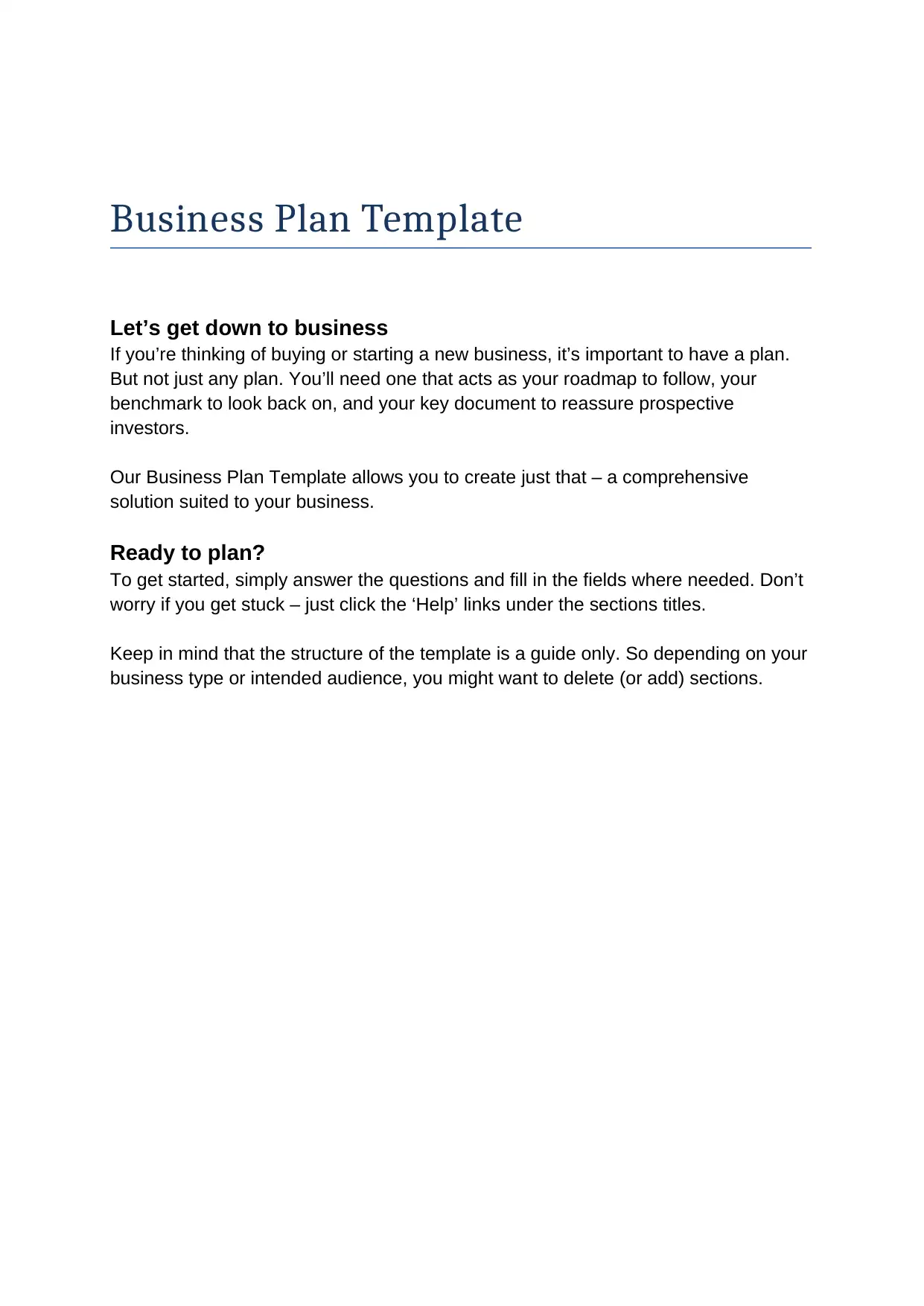
Business Plan Template
Let’s get down to business
If you’re thinking of buying or starting a new business, it’s important to have a plan.
But not just any plan. You’ll need one that acts as your roadmap to follow, your
benchmark to look back on, and your key document to reassure prospective
investors.
Our Business Plan Template allows you to create just that – a comprehensive
solution suited to your business.
Ready to plan?
To get started, simply answer the questions and fill in the fields where needed. Don’t
worry if you get stuck – just click the ‘Help’ links under the sections titles.
Keep in mind that the structure of the template is a guide only. So depending on your
business type or intended audience, you might want to delete (or add) sections.
Let’s get down to business
If you’re thinking of buying or starting a new business, it’s important to have a plan.
But not just any plan. You’ll need one that acts as your roadmap to follow, your
benchmark to look back on, and your key document to reassure prospective
investors.
Our Business Plan Template allows you to create just that – a comprehensive
solution suited to your business.
Ready to plan?
To get started, simply answer the questions and fill in the fields where needed. Don’t
worry if you get stuck – just click the ‘Help’ links under the sections titles.
Keep in mind that the structure of the template is a guide only. So depending on your
business type or intended audience, you might want to delete (or add) sections.
Paraphrase This Document
Need a fresh take? Get an instant paraphrase of this document with our AI Paraphraser
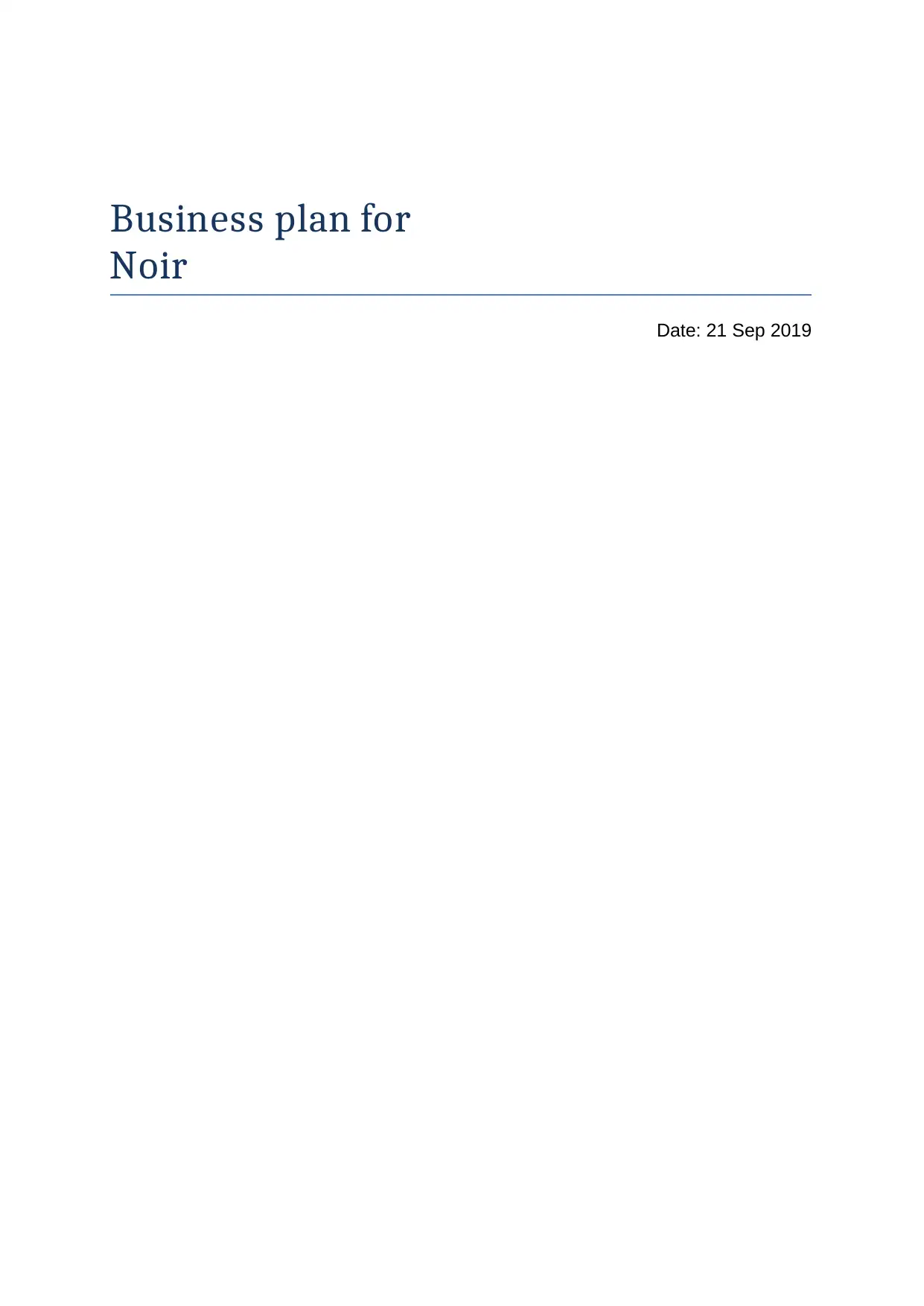
Business plan for
Noir
Date: 21 Sep 2019
Noir
Date: 21 Sep 2019
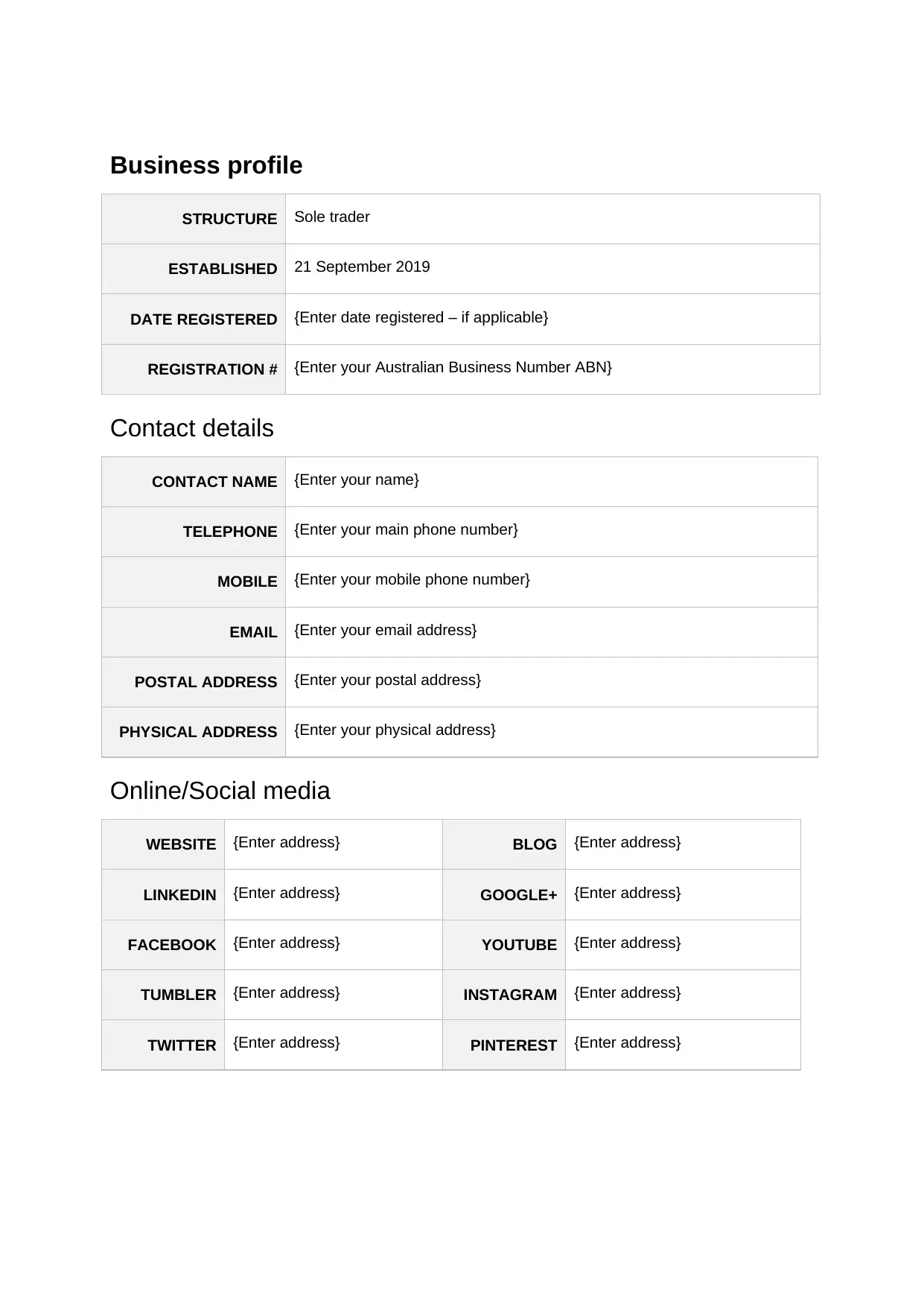
Business profile
STRUCTURE Sole trader
ESTABLISHED 21 September 2019
DATE REGISTERED {Enter date registered – if applicable}
REGISTRATION # {Enter your Australian Business Number ABN}
Contact details
CONTACT NAME {Enter your name}
TELEPHONE {Enter your main phone number}
MOBILE {Enter your mobile phone number}
EMAIL {Enter your email address}
POSTAL ADDRESS {Enter your postal address}
PHYSICAL ADDRESS {Enter your physical address}
Online/Social media
WEBSITE {Enter address} BLOG {Enter address}
LINKEDIN {Enter address} GOOGLE+ {Enter address}
FACEBOOK {Enter address} YOUTUBE {Enter address}
TUMBLER {Enter address} INSTAGRAM {Enter address}
TWITTER {Enter address} PINTEREST {Enter address}
STRUCTURE Sole trader
ESTABLISHED 21 September 2019
DATE REGISTERED {Enter date registered – if applicable}
REGISTRATION # {Enter your Australian Business Number ABN}
Contact details
CONTACT NAME {Enter your name}
TELEPHONE {Enter your main phone number}
MOBILE {Enter your mobile phone number}
EMAIL {Enter your email address}
POSTAL ADDRESS {Enter your postal address}
PHYSICAL ADDRESS {Enter your physical address}
Online/Social media
WEBSITE {Enter address} BLOG {Enter address}
LINKEDIN {Enter address} GOOGLE+ {Enter address}
FACEBOOK {Enter address} YOUTUBE {Enter address}
TUMBLER {Enter address} INSTAGRAM {Enter address}
TWITTER {Enter address} PINTEREST {Enter address}
⊘ This is a preview!⊘
Do you want full access?
Subscribe today to unlock all pages.

Trusted by 1+ million students worldwide
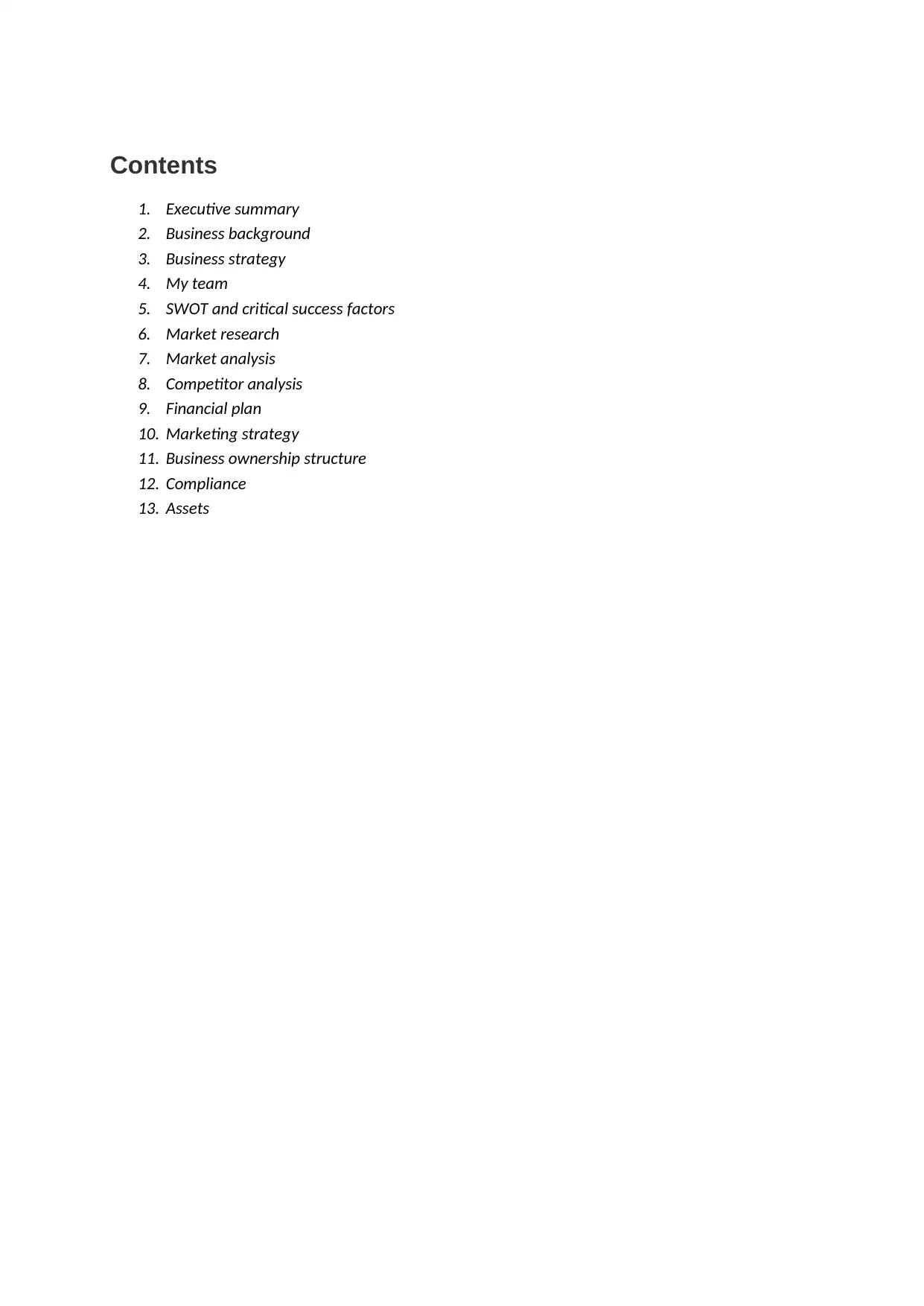
Contents
1. Executive summary
2. Business background
3. Business strategy
4. My team
5. SWOT and critical success factors
6. Market research
7. Market analysis
8. Competitor analysis
9. Financial plan
10. Marketing strategy
11. Business ownership structure
12. Compliance
13. Assets
1. Executive summary
2. Business background
3. Business strategy
4. My team
5. SWOT and critical success factors
6. Market research
7. Market analysis
8. Competitor analysis
9. Financial plan
10. Marketing strategy
11. Business ownership structure
12. Compliance
13. Assets
Paraphrase This Document
Need a fresh take? Get an instant paraphrase of this document with our AI Paraphraser
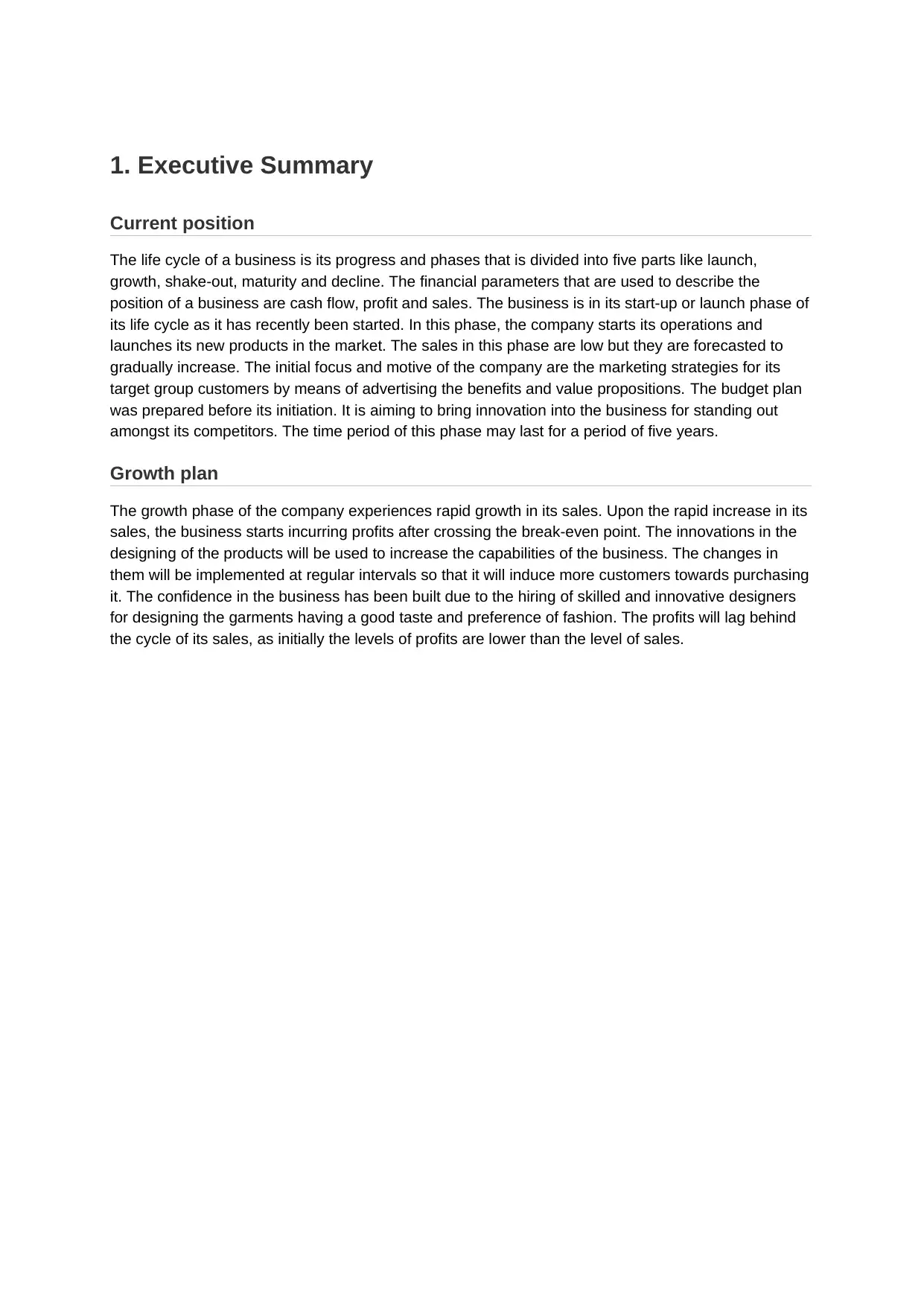
1. Executive Summary
Current position
The life cycle of a business is its progress and phases that is divided into five parts like launch,
growth, shake-out, maturity and decline. The financial parameters that are used to describe the
position of a business are cash flow, profit and sales. The business is in its start-up or launch phase of
its life cycle as it has recently been started. In this phase, the company starts its operations and
launches its new products in the market. The sales in this phase are low but they are forecasted to
gradually increase. The initial focus and motive of the company are the marketing strategies for its
target group customers by means of advertising the benefits and value propositions. The budget plan
was prepared before its initiation. It is aiming to bring innovation into the business for standing out
amongst its competitors. The time period of this phase may last for a period of five years.
Growth plan
The growth phase of the company experiences rapid growth in its sales. Upon the rapid increase in its
sales, the business starts incurring profits after crossing the break-even point. The innovations in the
designing of the products will be used to increase the capabilities of the business. The changes in
them will be implemented at regular intervals so that it will induce more customers towards purchasing
it. The confidence in the business has been built due to the hiring of skilled and innovative designers
for designing the garments having a good taste and preference of fashion. The profits will lag behind
the cycle of its sales, as initially the levels of profits are lower than the level of sales.
Current position
The life cycle of a business is its progress and phases that is divided into five parts like launch,
growth, shake-out, maturity and decline. The financial parameters that are used to describe the
position of a business are cash flow, profit and sales. The business is in its start-up or launch phase of
its life cycle as it has recently been started. In this phase, the company starts its operations and
launches its new products in the market. The sales in this phase are low but they are forecasted to
gradually increase. The initial focus and motive of the company are the marketing strategies for its
target group customers by means of advertising the benefits and value propositions. The budget plan
was prepared before its initiation. It is aiming to bring innovation into the business for standing out
amongst its competitors. The time period of this phase may last for a period of five years.
Growth plan
The growth phase of the company experiences rapid growth in its sales. Upon the rapid increase in its
sales, the business starts incurring profits after crossing the break-even point. The innovations in the
designing of the products will be used to increase the capabilities of the business. The changes in
them will be implemented at regular intervals so that it will induce more customers towards purchasing
it. The confidence in the business has been built due to the hiring of skilled and innovative designers
for designing the garments having a good taste and preference of fashion. The profits will lag behind
the cycle of its sales, as initially the levels of profits are lower than the level of sales.
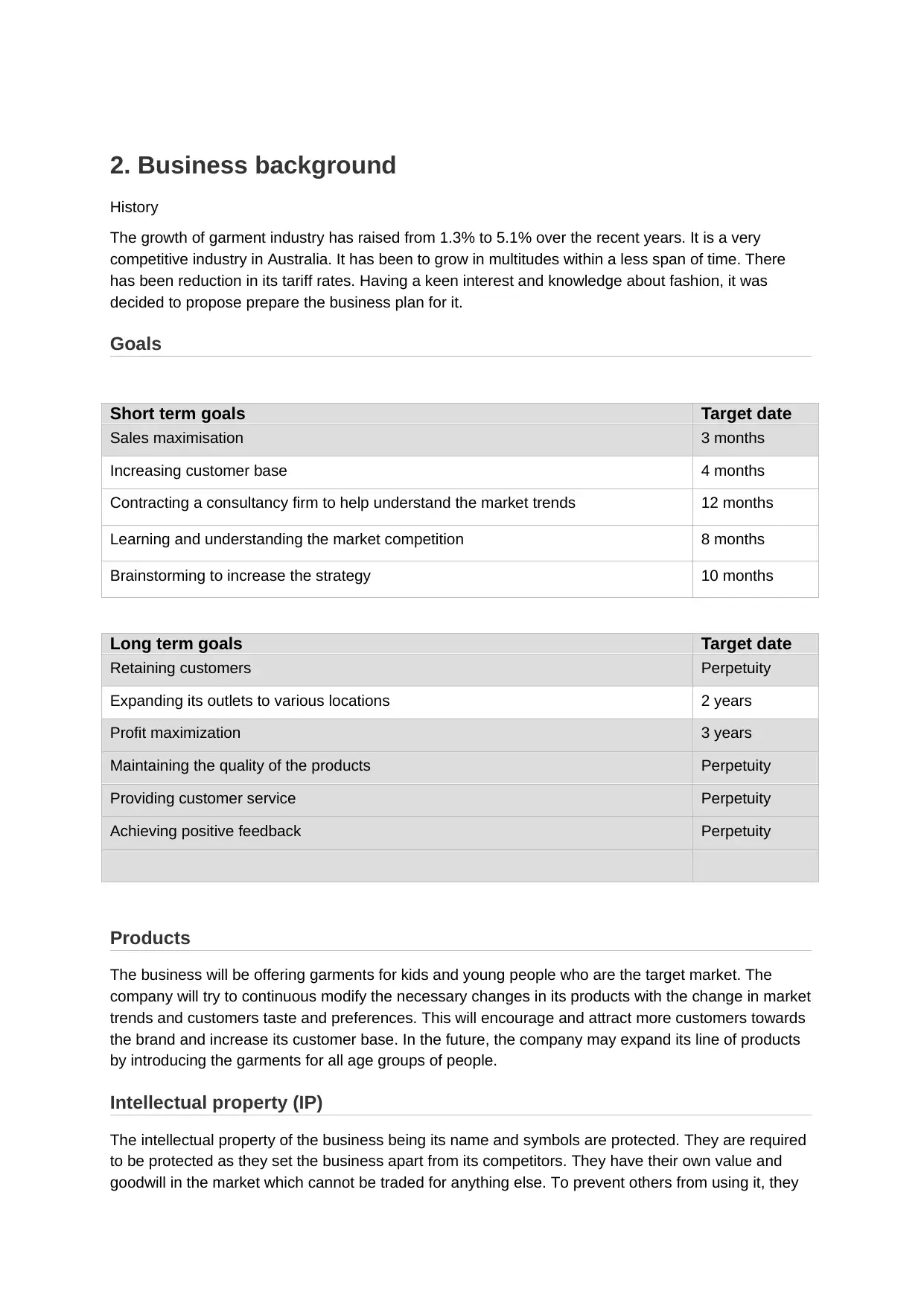
2. Business background
History
The growth of garment industry has raised from 1.3% to 5.1% over the recent years. It is a very
competitive industry in Australia. It has been to grow in multitudes within a less span of time. There
has been reduction in its tariff rates. Having a keen interest and knowledge about fashion, it was
decided to propose prepare the business plan for it.
Goals
Short term goals Target date
Sales maximisation 3 months
Increasing customer base 4 months
Contracting a consultancy firm to help understand the market trends 12 months
Learning and understanding the market competition 8 months
Brainstorming to increase the strategy 10 months
Long term goals Target date
Retaining customers Perpetuity
Expanding its outlets to various locations 2 years
Profit maximization 3 years
Maintaining the quality of the products Perpetuity
Providing customer service Perpetuity
Achieving positive feedback Perpetuity
Products
The business will be offering garments for kids and young people who are the target market. The
company will try to continuous modify the necessary changes in its products with the change in market
trends and customers taste and preferences. This will encourage and attract more customers towards
the brand and increase its customer base. In the future, the company may expand its line of products
by introducing the garments for all age groups of people.
Intellectual property (IP)
The intellectual property of the business being its name and symbols are protected. They are required
to be protected as they set the business apart from its competitors. They have their own value and
goodwill in the market which cannot be traded for anything else. To prevent others from using it, they
History
The growth of garment industry has raised from 1.3% to 5.1% over the recent years. It is a very
competitive industry in Australia. It has been to grow in multitudes within a less span of time. There
has been reduction in its tariff rates. Having a keen interest and knowledge about fashion, it was
decided to propose prepare the business plan for it.
Goals
Short term goals Target date
Sales maximisation 3 months
Increasing customer base 4 months
Contracting a consultancy firm to help understand the market trends 12 months
Learning and understanding the market competition 8 months
Brainstorming to increase the strategy 10 months
Long term goals Target date
Retaining customers Perpetuity
Expanding its outlets to various locations 2 years
Profit maximization 3 years
Maintaining the quality of the products Perpetuity
Providing customer service Perpetuity
Achieving positive feedback Perpetuity
Products
The business will be offering garments for kids and young people who are the target market. The
company will try to continuous modify the necessary changes in its products with the change in market
trends and customers taste and preferences. This will encourage and attract more customers towards
the brand and increase its customer base. In the future, the company may expand its line of products
by introducing the garments for all age groups of people.
Intellectual property (IP)
The intellectual property of the business being its name and symbols are protected. They are required
to be protected as they set the business apart from its competitors. They have their own value and
goodwill in the market which cannot be traded for anything else. To prevent others from using it, they
⊘ This is a preview!⊘
Do you want full access?
Subscribe today to unlock all pages.

Trusted by 1+ million students worldwide
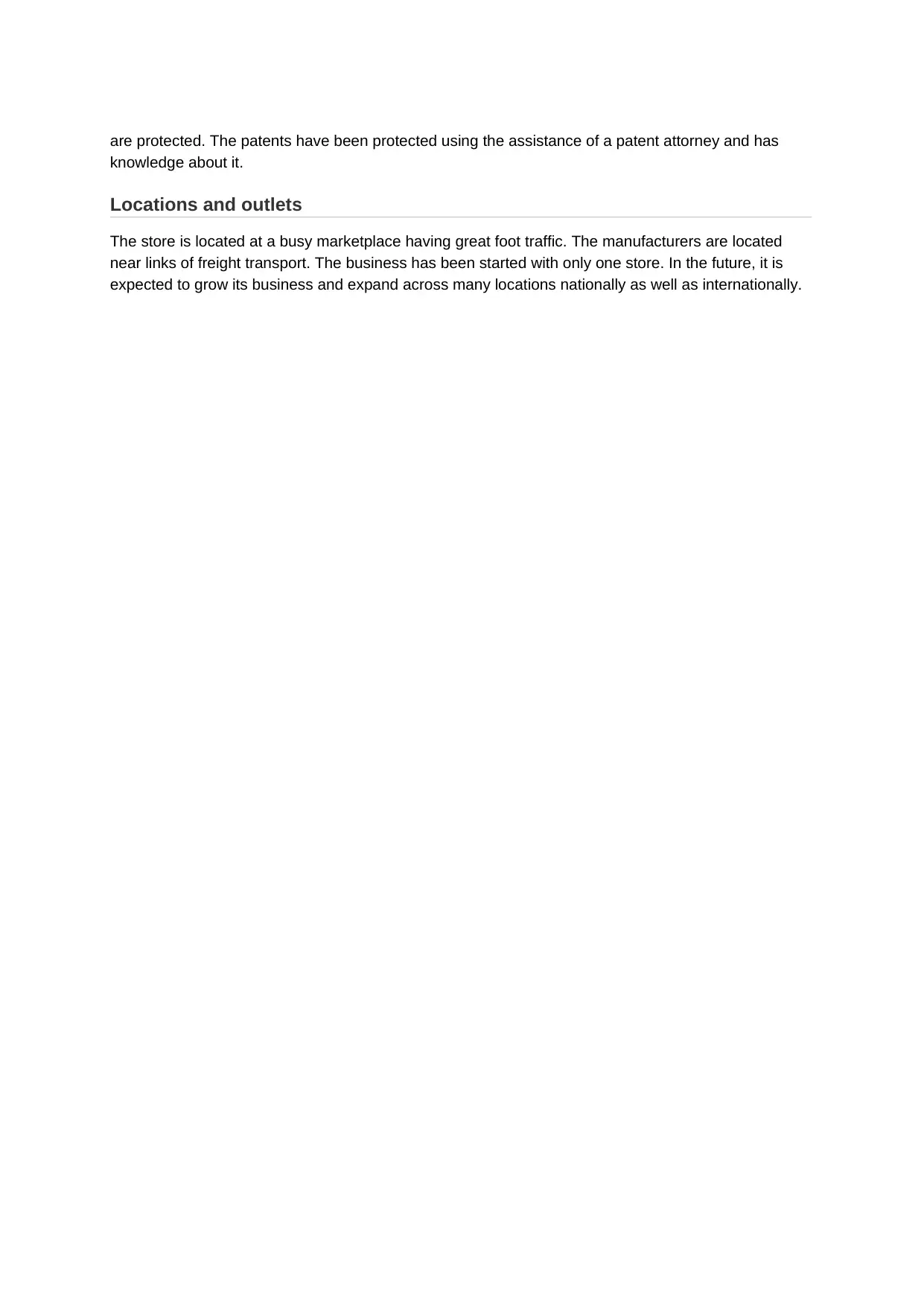
are protected. The patents have been protected using the assistance of a patent attorney and has
knowledge about it.
Locations and outlets
The store is located at a busy marketplace having great foot traffic. The manufacturers are located
near links of freight transport. The business has been started with only one store. In the future, it is
expected to grow its business and expand across many locations nationally as well as internationally.
knowledge about it.
Locations and outlets
The store is located at a busy marketplace having great foot traffic. The manufacturers are located
near links of freight transport. The business has been started with only one store. In the future, it is
expected to grow its business and expand across many locations nationally as well as internationally.
Paraphrase This Document
Need a fresh take? Get an instant paraphrase of this document with our AI Paraphraser
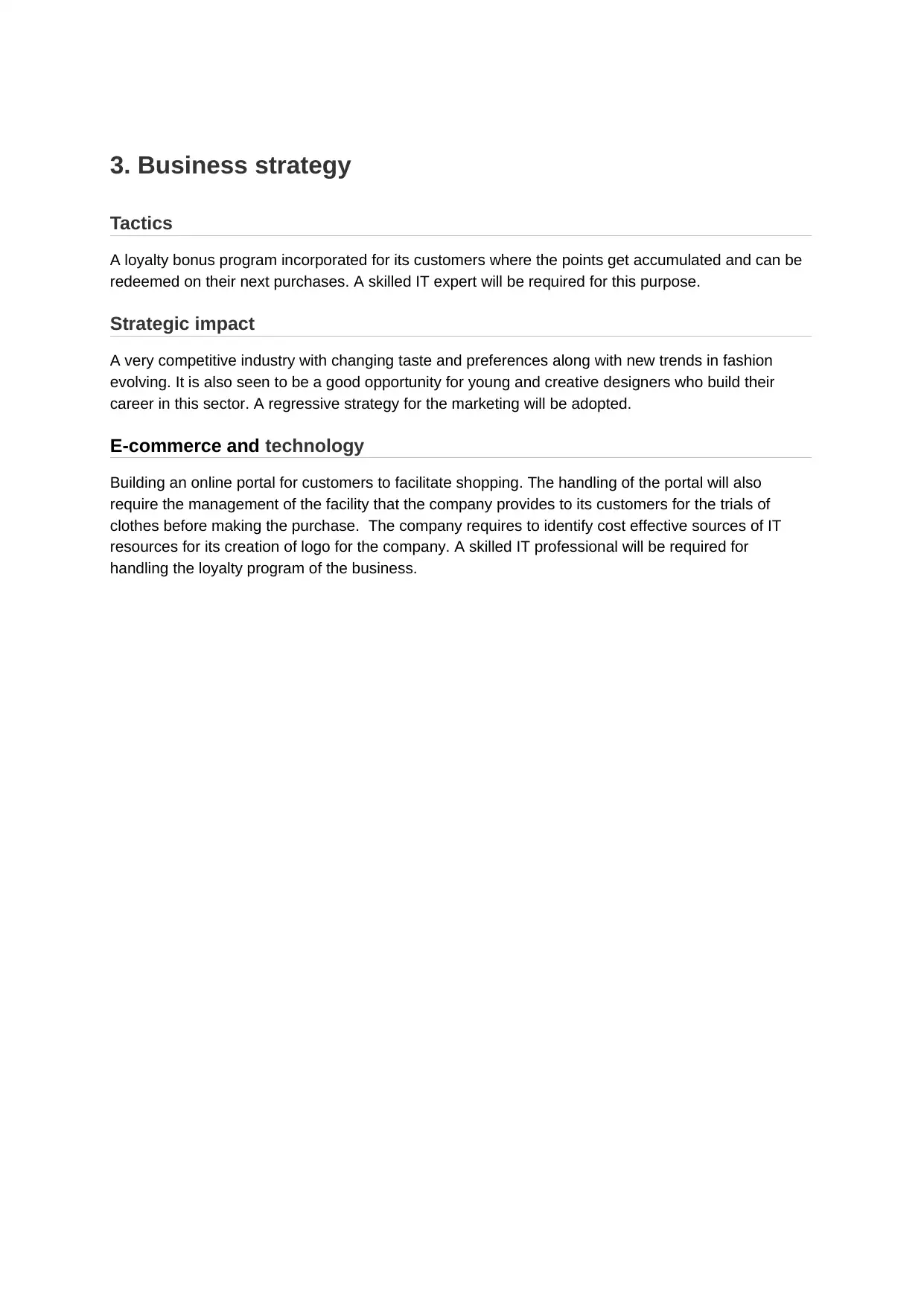
3. Business strategy
Tactics
A loyalty bonus program incorporated for its customers where the points get accumulated and can be
redeemed on their next purchases. A skilled IT expert will be required for this purpose.
Strategic impact
A very competitive industry with changing taste and preferences along with new trends in fashion
evolving. It is also seen to be a good opportunity for young and creative designers who build their
career in this sector. A regressive strategy for the marketing will be adopted.
E-commerce and technology
Building an online portal for customers to facilitate shopping. The handling of the portal will also
require the management of the facility that the company provides to its customers for the trials of
clothes before making the purchase. The company requires to identify cost effective sources of IT
resources for its creation of logo for the company. A skilled IT professional will be required for
handling the loyalty program of the business.
Tactics
A loyalty bonus program incorporated for its customers where the points get accumulated and can be
redeemed on their next purchases. A skilled IT expert will be required for this purpose.
Strategic impact
A very competitive industry with changing taste and preferences along with new trends in fashion
evolving. It is also seen to be a good opportunity for young and creative designers who build their
career in this sector. A regressive strategy for the marketing will be adopted.
E-commerce and technology
Building an online portal for customers to facilitate shopping. The handling of the portal will also
require the management of the facility that the company provides to its customers for the trials of
clothes before making the purchase. The company requires to identify cost effective sources of IT
resources for its creation of logo for the company. A skilled IT professional will be required for
handling the loyalty program of the business.
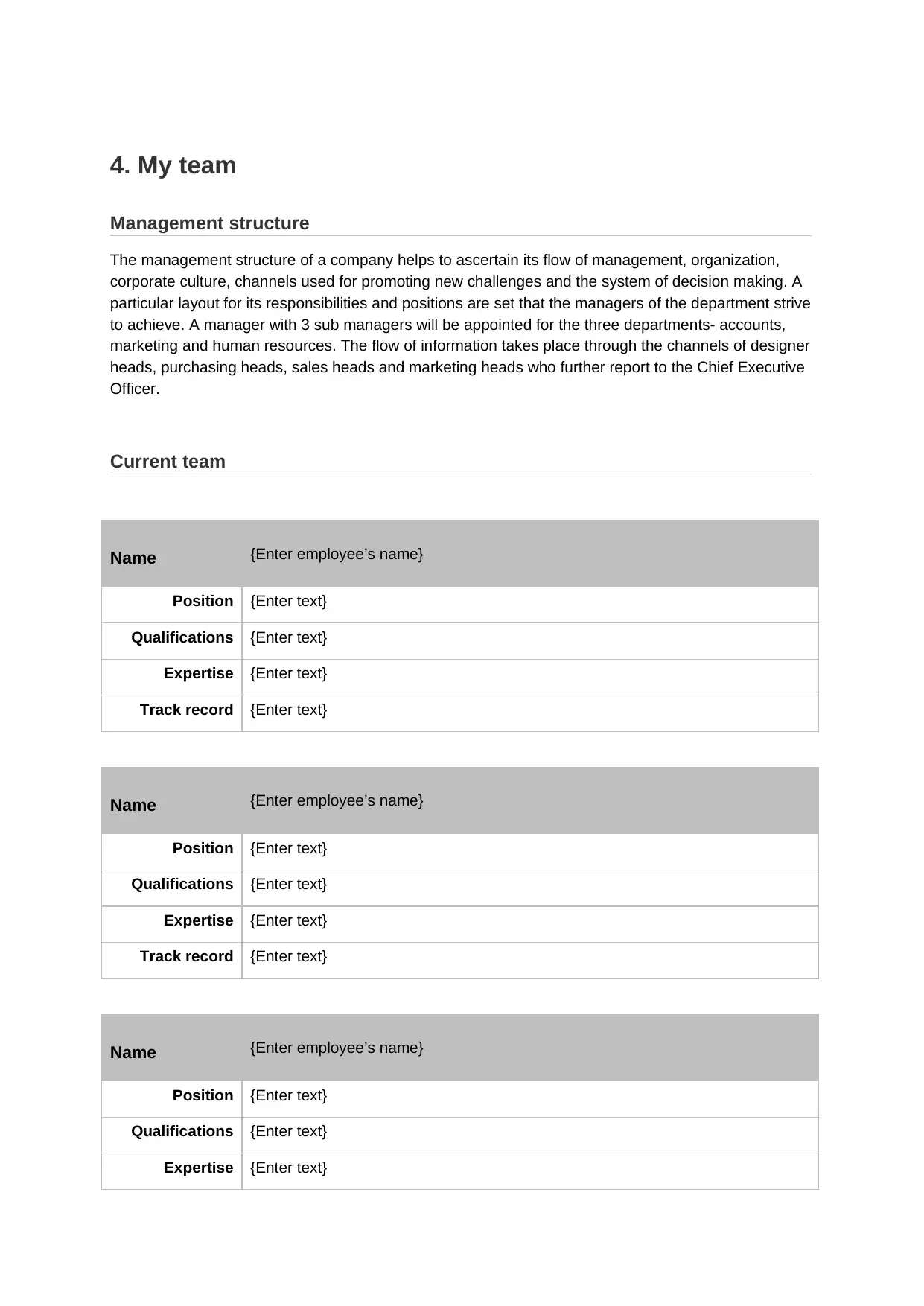
4. My team
Management structure
The management structure of a company helps to ascertain its flow of management, organization,
corporate culture, channels used for promoting new challenges and the system of decision making. A
particular layout for its responsibilities and positions are set that the managers of the department strive
to achieve. A manager with 3 sub managers will be appointed for the three departments- accounts,
marketing and human resources. The flow of information takes place through the channels of designer
heads, purchasing heads, sales heads and marketing heads who further report to the Chief Executive
Officer.
Current team
Name {Enter employee’s name}
Position {Enter text}
Qualifications {Enter text}
Expertise {Enter text}
Track record {Enter text}
Name {Enter employee’s name}
Position {Enter text}
Qualifications {Enter text}
Expertise {Enter text}
Track record {Enter text}
Name {Enter employee’s name}
Position {Enter text}
Qualifications {Enter text}
Expertise {Enter text}
Management structure
The management structure of a company helps to ascertain its flow of management, organization,
corporate culture, channels used for promoting new challenges and the system of decision making. A
particular layout for its responsibilities and positions are set that the managers of the department strive
to achieve. A manager with 3 sub managers will be appointed for the three departments- accounts,
marketing and human resources. The flow of information takes place through the channels of designer
heads, purchasing heads, sales heads and marketing heads who further report to the Chief Executive
Officer.
Current team
Name {Enter employee’s name}
Position {Enter text}
Qualifications {Enter text}
Expertise {Enter text}
Track record {Enter text}
Name {Enter employee’s name}
Position {Enter text}
Qualifications {Enter text}
Expertise {Enter text}
Track record {Enter text}
Name {Enter employee’s name}
Position {Enter text}
Qualifications {Enter text}
Expertise {Enter text}
⊘ This is a preview!⊘
Do you want full access?
Subscribe today to unlock all pages.

Trusted by 1+ million students worldwide
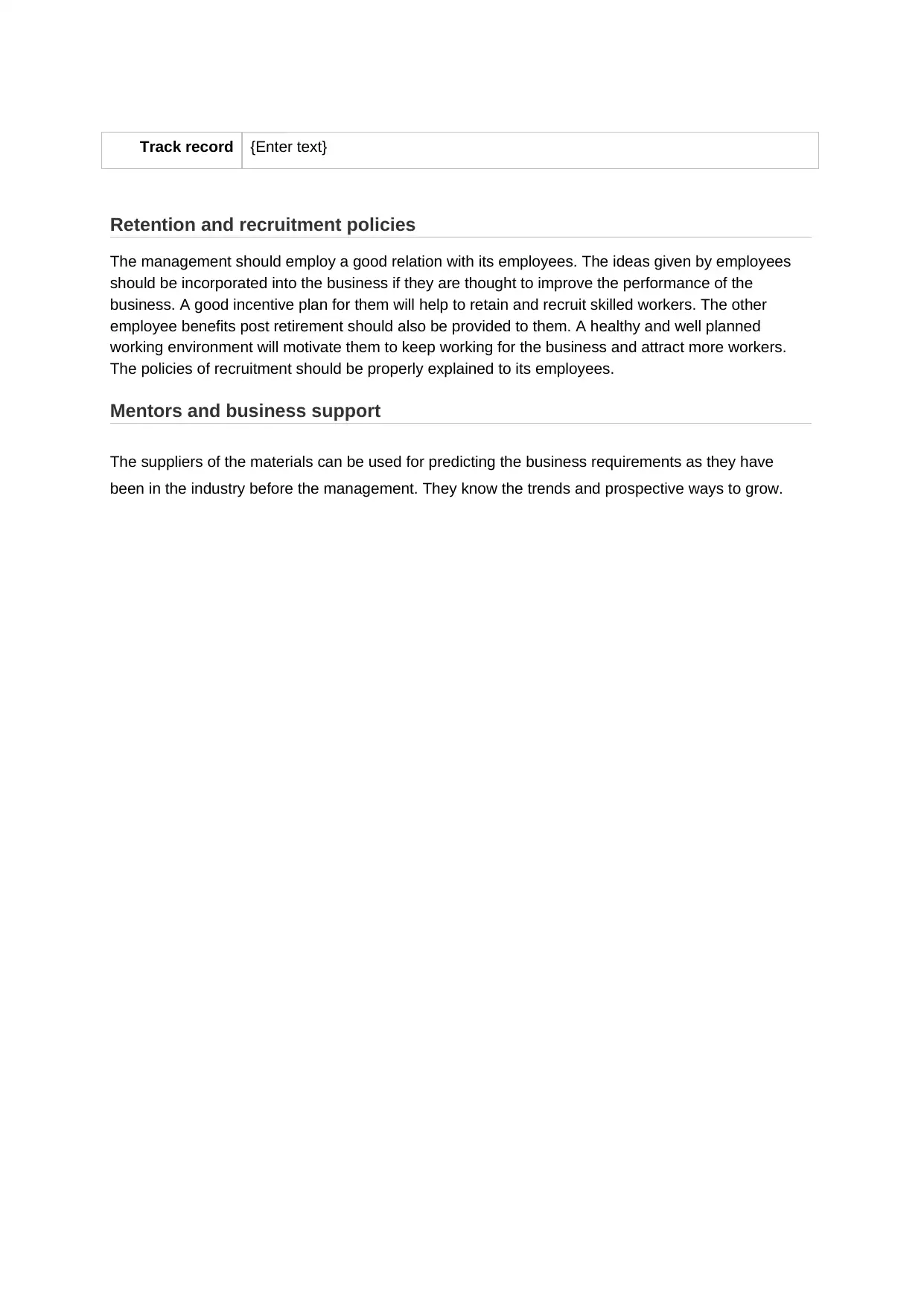
Track record {Enter text}
Retention and recruitment policies
The management should employ a good relation with its employees. The ideas given by employees
should be incorporated into the business if they are thought to improve the performance of the
business. A good incentive plan for them will help to retain and recruit skilled workers. The other
employee benefits post retirement should also be provided to them. A healthy and well planned
working environment will motivate them to keep working for the business and attract more workers.
The policies of recruitment should be properly explained to its employees.
Mentors and business support
The suppliers of the materials can be used for predicting the business requirements as they have
been in the industry before the management. They know the trends and prospective ways to grow.
Retention and recruitment policies
The management should employ a good relation with its employees. The ideas given by employees
should be incorporated into the business if they are thought to improve the performance of the
business. A good incentive plan for them will help to retain and recruit skilled workers. The other
employee benefits post retirement should also be provided to them. A healthy and well planned
working environment will motivate them to keep working for the business and attract more workers.
The policies of recruitment should be properly explained to its employees.
Mentors and business support
The suppliers of the materials can be used for predicting the business requirements as they have
been in the industry before the management. They know the trends and prospective ways to grow.
Paraphrase This Document
Need a fresh take? Get an instant paraphrase of this document with our AI Paraphraser
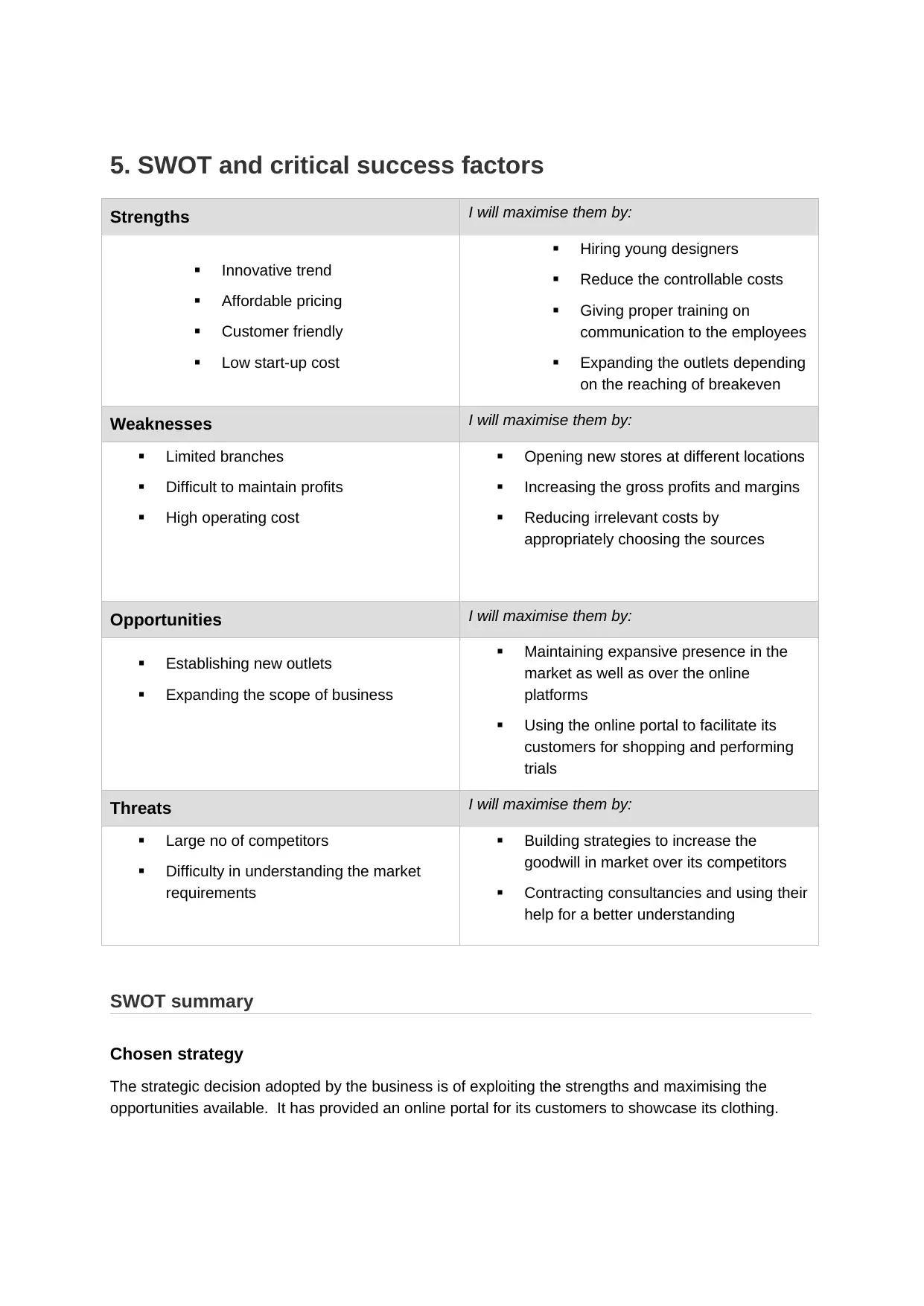
5. SWOT and critical success factors
Strengths I will maximise them by:
Innovative trend
Affordable pricing
Customer friendly
Low start-up cost
Hiring young designers
Reduce the controllable costs
Giving proper training on
communication to the employees
Expanding the outlets depending
on the reaching of breakeven
Weaknesses I will maximise them by:
Limited branches
Difficult to maintain profits
High operating cost
Opening new stores at different locations
Increasing the gross profits and margins
Reducing irrelevant costs by
appropriately choosing the sources
Opportunities I will maximise them by:
Establishing new outlets
Expanding the scope of business
Maintaining expansive presence in the
market as well as over the online
platforms
Using the online portal to facilitate its
customers for shopping and performing
trials
Threats I will maximise them by:
Large no of competitors
Difficulty in understanding the market
requirements
Building strategies to increase the
goodwill in market over its competitors
Contracting consultancies and using their
help for a better understanding
SWOT summary
Chosen strategy
The strategic decision adopted by the business is of exploiting the strengths and maximising the
opportunities available. It has provided an online portal for its customers to showcase its clothing.
Strengths I will maximise them by:
Innovative trend
Affordable pricing
Customer friendly
Low start-up cost
Hiring young designers
Reduce the controllable costs
Giving proper training on
communication to the employees
Expanding the outlets depending
on the reaching of breakeven
Weaknesses I will maximise them by:
Limited branches
Difficult to maintain profits
High operating cost
Opening new stores at different locations
Increasing the gross profits and margins
Reducing irrelevant costs by
appropriately choosing the sources
Opportunities I will maximise them by:
Establishing new outlets
Expanding the scope of business
Maintaining expansive presence in the
market as well as over the online
platforms
Using the online portal to facilitate its
customers for shopping and performing
trials
Threats I will maximise them by:
Large no of competitors
Difficulty in understanding the market
requirements
Building strategies to increase the
goodwill in market over its competitors
Contracting consultancies and using their
help for a better understanding
SWOT summary
Chosen strategy
The strategic decision adopted by the business is of exploiting the strengths and maximising the
opportunities available. It has provided an online portal for its customers to showcase its clothing.
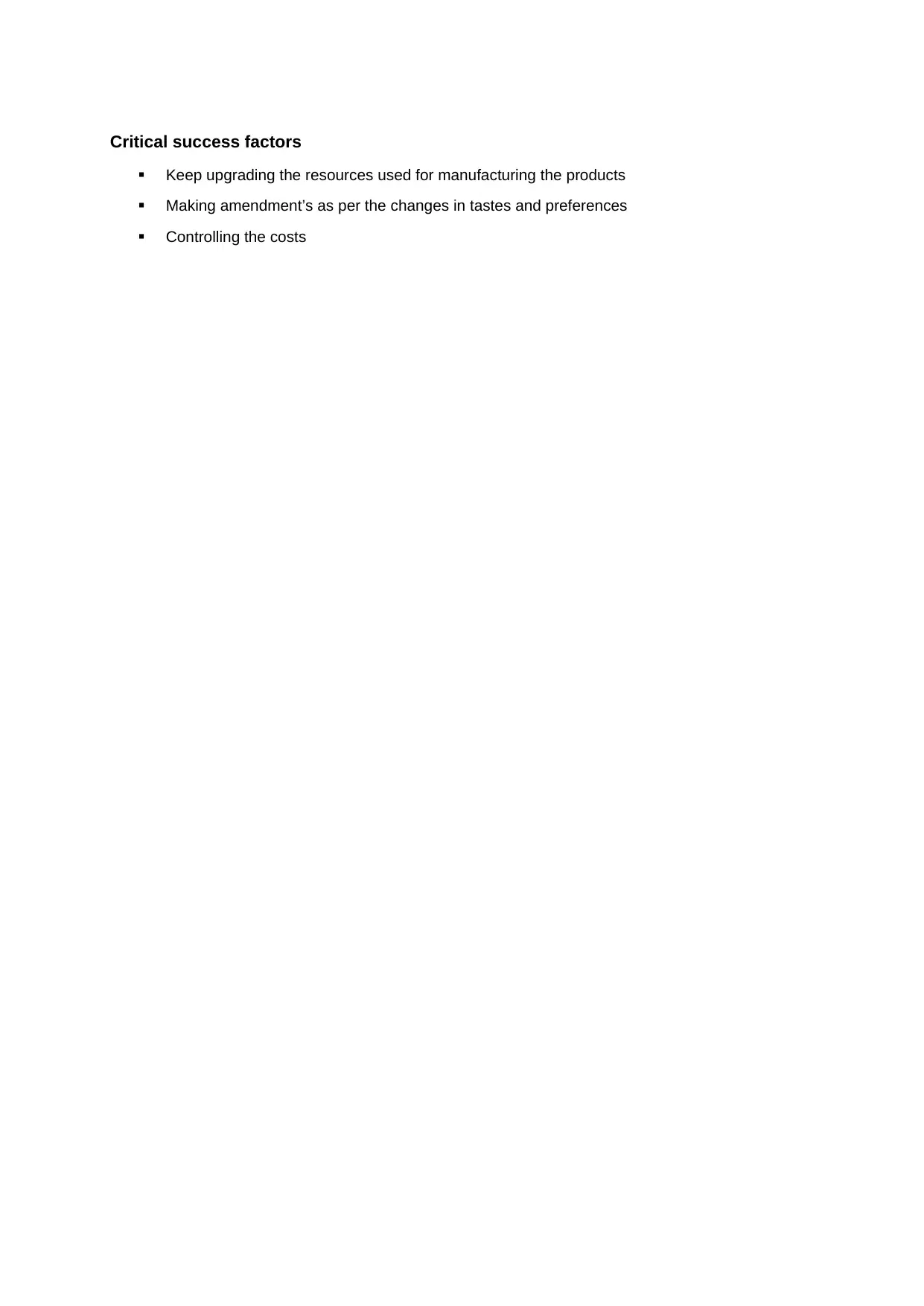
Critical success factors
Keep upgrading the resources used for manufacturing the products
Making amendment’s as per the changes in tastes and preferences
Controlling the costs
Keep upgrading the resources used for manufacturing the products
Making amendment’s as per the changes in tastes and preferences
Controlling the costs
⊘ This is a preview!⊘
Do you want full access?
Subscribe today to unlock all pages.

Trusted by 1+ million students worldwide
1 out of 29
Related Documents
Your All-in-One AI-Powered Toolkit for Academic Success.
+13062052269
info@desklib.com
Available 24*7 on WhatsApp / Email
![[object Object]](/_next/static/media/star-bottom.7253800d.svg)
Unlock your academic potential
Copyright © 2020–2025 A2Z Services. All Rights Reserved. Developed and managed by ZUCOL.





